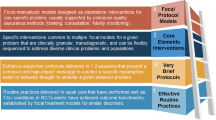Abstract
The use of evidence-based assessment practices seems to be a straightforward process to endorse. Having evidence that ties a practice to prediction, prescription, or process has the potential to advance overall practice in School Psychology in ways that have already been seen in medicine and, to a lesser degree, clinical psychology. However, the transition to an EBA focus would require substantial changes in how measures are created and validated, how new practitioners are taught to perform assessments and how current practitioners are educated into a new process, how interventions are conceptualized and tested, and how the progress of individuals receiving those interventions is monitored.
Similar content being viewed by others
References
Bayes, T., & Price, R. (1763). An essay towards solving a problem in the doctrine of chance. By the late Rev. Mr. Bayes, communicated by Mr. Price, in a letter to John Canton, M. A. And F. R. S. Philosophical Transactions of the Royal Society of London, 53, 370–418.
Caraguel, C., & Vanderstichel, R. (2013). The two-step Fagan’s nomogram: ad hoc interpretation of a diagnostic test result without calculation. Evidence Based Medicine, 18, 125–128.
Devena, S. E., & Watkins, M. W. (2012). Diagnostic utility of WISC-IV general abilities index and cognitive proficiency index difference scores among children with ADHD. Journal of Applied School Psychology, 28, 133–154. https://doi.org/10.1080/15377903.2012.669743.
Evidence Based Assessment (n.d.). In Wikiversity. Retrieved October 3, 2018, from https://en.wikiversity.org/wiki/Evidence_based_assessment.
Foster, S. L., & Cone, J. D. (1995). Validity issues in clinical assessment. Psychological Assessment, 7, 248–260. https://doi.org/10.1037/1040-3590.7.3.248.
Garland, A. F., Kruse, M., & Aarons, G. A. (2003). Clinicians and outcome measurement: what’s the use? The Journal of Behavioral Health Services & Research, 30(4), 393–405. https://doi.org/10.1007/BF02287427.
Gilbody, S. M., House, A. O., & Sheldon, T. A. (2002). Psychiatrists in the UK do not use outcomes measures: National survey. British Journal of Psychiatry, 180(2), 101–103.
Hunsley, J., & Mash, E. J. (2007). Evidenced-based assessment. Annual Review of Clinical Psychology, 3, 29–51. https://doi.org/10.1146/annurev.clinpsy.3.022806.091419.
Jensen. P. S. (2003). Comorbidity and child psychopathology: Recommendations for the next decade. Joumal of Abnormal Child Psychology, 31, 293-300.
Jensen-Doss, A., & Hawley, K. M. (2010). Understanding barriers to evidence-based assessment: Clinician attitudes toward standardized assessment tools. Journal of Clinical Child and Adolescent Psychology, 39(6), 885–896.
Mash, E. J., & Hunsley, J. (2005). Evidence-based assessment of child and adolescent disorders: issues and challenges. Journal of Clinical Child & Adolescent Psychology, 34(3), 362–379. https://doi.org/10.1207/s15374424jccp3403pass:[_]1.
McFall, R. M., & Treat, T. A. (1999). Quantifying the information value of clinical assessments with signal detection theory. Annual Review of Psychology, 50(1), 215–241. https://doi.org/10.1146/annurev.psych.50.1.215.
Meehl, P. E. (1989). Law and the fireside inductions (with postscript): some reflections of a clinical psychologist. Behavioral Sciences & the Law, 7, 521–550. https://doi.org/10.1002/bsl.2370070408.
Meehl, P. E., & Rosen, A. (1955). Antecedent probability and the efficiency of psychometric signs, patterns, or cutting scores. Psychological Bulletin, 55, 194–216. https://doi.org/10.1037/h0048070.
Moura, O., Simões, M. R., & Pereira, M. (2013). WISC-III cognitive profiles in children with developmental dyslexia: specific cognitive disability and diagnostic utility. Dyslexia, 20, 19–37. https://doi.org/10.1002/dys.1468.
Styck, K. M., & Watkins, M. W. (2014). Discriminant validity of the WISC-IV culture-language interpretive matrix. Contemporary School Psychology, 18, 168–177. https://doi.org/10.1007/s40688-014-0021-y.
Weiner, I. B. (2003). Prediction and postdiction in clinical decision making. Clinical Psychology: Science and Practice, 10, 335–338. https://doi.org/10.1093/clipsy/bpg030.
Whiting, P. F., Rutjes, A. W., Westwood, M. E., Mallett, S., Deeks, J. J., Reitsma, J. B., & Bossuyt, P. M. (2011). QUADAS-2: A revised tool for the quality assessment of diagnostic accuracy studies. Annals of Internal Medicine, 155, 529–536. https://doi.org/10.1059/0003-4819.
Youngstrom, E. (2008). Commentary: Evidence-based assessment is not avidence—based medicine—Commentary on evidence-based assessment of cognitive functioning in pediatric psychology. Journal of Pediatric Psychology, 33(9), 1015–1020.
Youngstrom, E. A. (2013). Future directions in psychological assessment: combining evidence-based medicine innovations with psychology’s historical strengths to enhance utility. Journal of Clinical Child & Adolescent Psychology, 42, 139–159. https://doi.org/10.1080/15374416.2012.736358.
Youngstrom, E. A. (2014). A primer on receiver operating characteristic analysis and diagnostic efficiency statistics for pediatric psychology: we are ready to ROC. Journal of Pediatric Psychology, 39(2), 204–221. https://doi.org/10.1093/jpepsy/jst062.
Youngstrom, E. A., & Van Meter, A. (2016). Empirically supported assessment of children and adolescents. Clinical Psychology: Science and Practice, 23(4), 327–347. https://doi.org/10.1111/cpsp.12172.
Youngstrom, E. A., Findling, R. L., Calabrese, J. R., Gracious, B. L., Demeter, C., DelPorto Bedoya, D., & Price, M. (2004). Comparing the diagnostic accuracy of six potential screening instruments for bipolar disorder in youths aged 5 to 17 years. Journal of the American Academy of Child and Adolescent Psychiatry, 43(7), 847–858. https://doi.org/10.1097/01.chi.0000125091.35109.1e.
Youngstrom, E. A., Choukas-Bradley, S., Calhoun, C. D., & Jensen-Doss, A. (2014). Clinical guide to the evidenced-based assessment approach to diagnosis and treatment. Cognitive and Behavioral Practice, 22, 20–35.
Author information
Authors and Affiliations
Corresponding author
Additional information
Publisher’s Note
Springer Nature remains neutral with regard to jurisdictional claims in published maps and institutional affiliations.
Rights and permissions
About this article
Cite this article
Ward, T.J. EBA: Good Idea but Is It Feasible?. Contemp School Psychol 23, 190–193 (2019). https://doi.org/10.1007/s40688-019-00239-y
Published:
Issue Date:
DOI: https://doi.org/10.1007/s40688-019-00239-y



